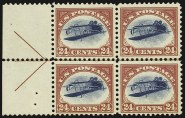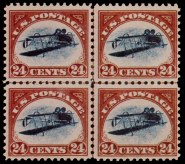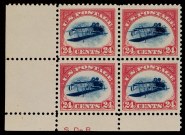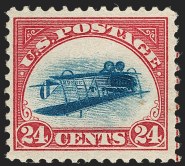Owner Biography
Y Souren
Y. Souren, whose real name was Souren Yohannasiants, came to the United States from his native Georgia. He had the good sense to concoct a name that eventually became a household word, at least among stamp collectors – Y. Souren. He knew people would not be able to properly spell or pronounce his original name.
Souren escaped Georgia just ahead of the Bolshevik army as it was overrunning his nation. He posed as a peasant driving a hay cart while escaping. Under the load of hay was his valuable collection of medieval and primitive clocks and timepieces.
After his arrival in this country he sold these clocks and timepieces to the Metropolitan Museum of Art in New York City. This undoubtedly helped him capitalize his stamp business and led to one of the most storied careers anyone ever had as a stamp dealer.
In the late 1930's Souren occupied a fancy office on Park Avenue, and visitors were admitted only after scrutiny, as though suspected members of a spy ring. He kept a private dossier on stamp dealers, collectors and those stamps that had passed through his hands. He had X-ray machines, ultraviolet apparatus and cameras at hand, and he was fond of bringing forth, with appreciative Near Eastern chuckles, photographs of what Herman Herst describes as "unquestionably the same item, perhaps with a straight edge [of a stamp] reperforated [to make it more valuable], a fancy cancel added or other stamps added to the cover." Souren also had photographs of ads by stamp dealers offering items that were misleading. "Comes in handy whenever I want something from someone who doesn't want to cooperate," Souren told Herst.
Years ahead of the FBI, Souren had a camera hidden in the ceiling of his front door, "He was always afraid of being robbed," Herst recalls in Nassau Street, "and with good reason, for in his heyday it is doubtful whether any premises short of the Bureau of Printing and Engraving and the stamp vaults in Washington held a more valuable accumulation of stamps. He showed me photographs of every person who had passed through that door in recent days. I saw my photograph several times."
Souren had very little regard for Communist Russia, but once the United States came into World War II on Russia’s side, he organized a large charitable stamp auction to aid his homeland. The auction, held at the Waldorf Astoria Hotel in New York City, attracted some of the biggest names in stamp collecting. Stamp rarities worth thousands of dollars were donated, helping bring in many thousands of dollars for Russian relief.
During his career as a stamp dealer he owned some of the most famous items in stamp collecting. One of these classics was the unique plate block of four of the 24-cent inverted jenny. Additionally, he had purchased the block of four of the 24-cent 1869 issue with inverted centers from the famous Crocker collection.
Ever the showman, he had this block mounted between two small panes of glass and he took it with him to occasionally show it off to someone he wanted to impress. Sometimes while in a restaurant eating lunch, he would just remove it from a special pocket in his coat and look at it as he enjoyed a meal.
Among other collectors, Y. Souren represented Amos Eno when building his collection.
Souren escaped Georgia just ahead of the Bolshevik army as it was overrunning his nation. He posed as a peasant driving a hay cart while escaping. Under the load of hay was his valuable collection of medieval and primitive clocks and timepieces.
After his arrival in this country he sold these clocks and timepieces to the Metropolitan Museum of Art in New York City. This undoubtedly helped him capitalize his stamp business and led to one of the most storied careers anyone ever had as a stamp dealer.
In the late 1930's Souren occupied a fancy office on Park Avenue, and visitors were admitted only after scrutiny, as though suspected members of a spy ring. He kept a private dossier on stamp dealers, collectors and those stamps that had passed through his hands. He had X-ray machines, ultraviolet apparatus and cameras at hand, and he was fond of bringing forth, with appreciative Near Eastern chuckles, photographs of what Herman Herst describes as "unquestionably the same item, perhaps with a straight edge [of a stamp] reperforated [to make it more valuable], a fancy cancel added or other stamps added to the cover." Souren also had photographs of ads by stamp dealers offering items that were misleading. "Comes in handy whenever I want something from someone who doesn't want to cooperate," Souren told Herst.
Years ahead of the FBI, Souren had a camera hidden in the ceiling of his front door, "He was always afraid of being robbed," Herst recalls in Nassau Street, "and with good reason, for in his heyday it is doubtful whether any premises short of the Bureau of Printing and Engraving and the stamp vaults in Washington held a more valuable accumulation of stamps. He showed me photographs of every person who had passed through that door in recent days. I saw my photograph several times."
Souren had very little regard for Communist Russia, but once the United States came into World War II on Russia’s side, he organized a large charitable stamp auction to aid his homeland. The auction, held at the Waldorf Astoria Hotel in New York City, attracted some of the biggest names in stamp collecting. Stamp rarities worth thousands of dollars were donated, helping bring in many thousands of dollars for Russian relief.
During his career as a stamp dealer he owned some of the most famous items in stamp collecting. One of these classics was the unique plate block of four of the 24-cent inverted jenny. Additionally, he had purchased the block of four of the 24-cent 1869 issue with inverted centers from the famous Crocker collection.
Ever the showman, he had this block mounted between two small panes of glass and he took it with him to occasionally show it off to someone he wanted to impress. Sometimes while in a restaurant eating lunch, he would just remove it from a special pocket in his coat and look at it as he enjoyed a meal.
Among other collectors, Y. Souren represented Amos Eno when building his collection.







